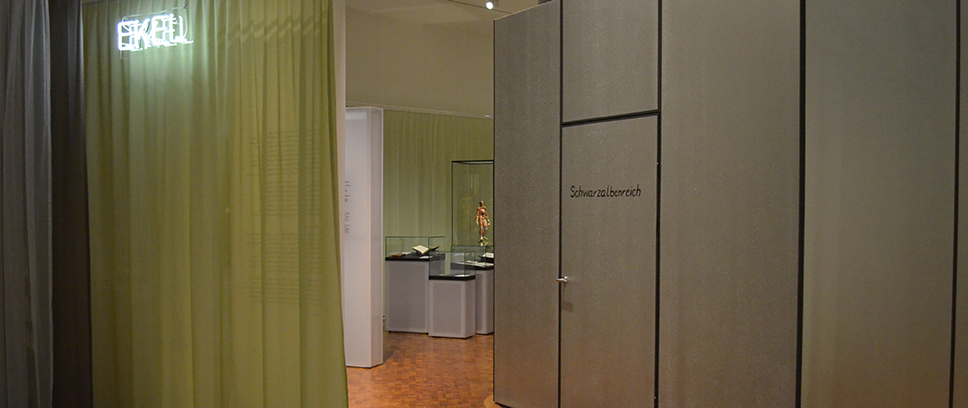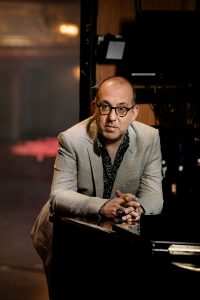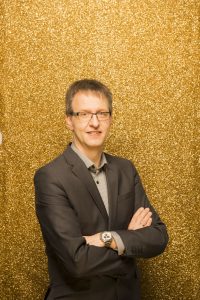
“Schwarzalbenreich” – Interview with Barrie Kosky and Ulrich Lenz
20 April 2022
Richard Wagner was an anti-Semite – this forms the basis for the installation “Schwarzalbenreich”, which the principal director and intendant of the Komische Oper Berlin, Barrie Kosky, created specially for the DHM exhibition “Richard Wagner and the Nationalization of Feeling”. A sound collage, presented in the darkness of a “Blackbox”, combines historical recordings with anti-Semitic Wagner quotes that have been translated into Yiddish. Ulrich Lenz, head dramaturg of the Komische Oper Berlin, oversaw the dramaturgical concept and supervision of the project. Lenz and Kosky talk about the installation in this interview.
What associations did the [German] title of the exhibition “Richard Wagner und das deutsche Gefühl” evoke in you?
Barrie Kosky: Ambivalent associations. For me feeling has positive connotations. “Das deutsche Gefühl” (German feeling), especially with Wagner, sounds rather more like sentimentality to me. All the more so, because Wagner always defines Germanness out of the rejection of the negatively connotated “other”. But this ambivalence is clearly intended by the makers of the exhibition.
Ulrich Lenz: I acutely mistrust the cult that surrounds Wagner and his music. Not all is gold with Wagner! Even though he himself propagated it throughout his life. The contradictoriness of his works fascinates and repels at the same time. But in any case, he is a gifted music dramatist who has created his own fascinating worlds, thanks to his sheer boundless imagination. At the same time, as with almost no other composer, all of his works are a mirror of their time and of the political circumstances in which they came about. This is what the title of the exhibition intends to reflect.
Wagner was anti-Semitic. How do you encounter his work against this backdrop?
Barrie Kosky: It is important not to separate his artistic work from what he said and wrote. Wagner is anti-Semitic through and through. In his operas as in his theoretical writings, in his libretti as in his music. In the end, every director must decide what that means for the interpretation of Wagner’s music dramas.
What is your personal connection with Wagner and his works?
Ulrich Lenz: I came relatively late to an appreciation of his works. Which lay not least on the length of many of his operas. I must admit: five hours of opera is pushing the limits of what I can take. No one can really concentrate that long. But Wagner’s music always demands complete attention, which Nietzsche pointed out in words to this effect: it’s always plucking on the strings of your jacket. That sometimes annoys me. And distracts my attention from the really magnificent moments in the works that I find too long. On the other hand, the Ring is, of course, grandiose, comprehensive world theatre. There’s so much in there that it is indeed right that you occupy yourself with it time and again. In my opinion, it should be performed not in four, but in ten days, like a series: every act a day with a longish pilot sequence – the Rheingold – to start it off! Then you would experience the individual “sequels” much more attentively! No doubt a sacrilege for die-hard Wagnerians …
How does the staging in a room in the DHM differ from a stage production for the theatre?
Barrie Kosky: In every respect! “Schwarzalbenreich” is purely a sound installation, a “cinema in the mind”, as it were. In complete darkness, the listeners are deluged with a four-minute “sound-downpour” that cannot and should not be encountered analytically. Nonetheless, we tried to funnel the texts and musical fragments into a musical-dramaturgical arc of suspense.
What were the main challenges for the production in the exhibition?
Ulrich Lenz: It required a long period of preparation. The Wagner quotes had to be researched and compiled and then translated into Yiddish by Michael Felsenbaum and recorded by Anna Rozenfeld. The historical recordings had to be found, which was not as easy as one would think. Then the appropriate excerpts had to be chosen. Perhaps the main challenge was to pour all that into a four-minute sound event that doesn’t consist of a mere row of quotes and music fragments, but which follows a dramaturgical course that aims less at the understanding than at the recipients’ subconscious. I find that our sound designer Sebastian Lipski was impressively successful at creating this “crazy collage”.
 © Jan Windszus |
Barrie Kosky
Barrie Kosky is a director in demand at the world’s major opera houses and festivals. Since the 2012/13 season he has been artistic director and chief director of the Komische Oper Berlin. |
Ulrich LenzUlrich Lenz studied musicology, theatre studies and art history in Munich, Berlin and Milan. Since the 2012/13 season, he has been head dramaturge at the Komische Oper Berlin in the team of Barrie Kosky, with whom he has a long-standing collaboration. |
 © Jan Windszus |